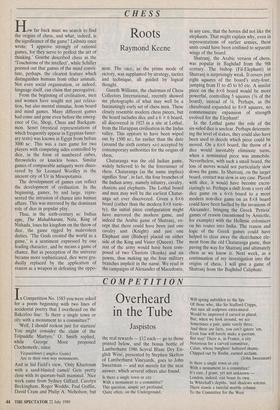CHESS
Roots
Raymond Keene
HoW far back must we search to find the origins of chess, and what, indeed, is the significance of the game? Leibnitz once wrote: 'I approve strongly of rational games, for they serve to perfect the art of thinking.' Goethe described chess as the `Touchstone of the intellect', while Schiller pointed out that games of the mind consti- tute, perhaps, the clearest feature which distinguishes humans from other animals. Not even social organisation, or indeed, language itself, can claim that prerogative. From the beginning of civilisation, men and women have sought not just relaxa- tion, but also mental stimulus, from board and mind games. Many different games had come and gone even before the emerg- ence of Go, Shogi, Chess and Backgam- mon. Senet (mystical representations of which frequently appear in Egyptian funer- ary texts) was known in Egypt from before 3000 sc. This was a race game for two players with competing sides controlled by dice, in the form of numbered cubes, throwsticks or knuckle bones. Similar games of comparable antiquity were disco- vered by Sir Leonard Woolley in the ancient city of Ur in Mesopotamia. The development of games can reflect the development of civilisation. In the beginning, games, by and large, repre- sented the intrusion of chance into human affairs. This was mirrored by the dominant role of dice in popular play. Thus, in the sixth-century sc Indian epic, The Mahabharata, Nala, King of Nishada, loses his kingdom on the throw of dice, the game rigged by malevolent deities. `The Gods created the world as a game,' is a sentiment expressed by one leading character, and he means a game of chance. But as perception of the universe became more sophisticated, dice were gra- dually replaced by the application of reason as a weapon in defeating the oppo- prime nent. The race, as the pme mode of victory, was supplanted by strategy, tactics and technique, all guided by logical thought. Gareth Williams, the chairman of Chess Collectors International, recently showed me photographs of what may well be a fascinatingly early set of chess men. These closely resemble modern chess pieces, but the hoard includes dice and a 6 x 6 board, all discovered in 1925 in a site at Lothal, from the Harappan civilisation in the Indus valley. This appears to have been wiped out by 1500 Eic, far earlier than the date AD) accepted by (around the sixth century contemporary authorities for the origins of chess. Chaturanga was the old Indian game, widely believed to be the forerunner of chess. Chaturanga (as the name implies) signifies 'four', in fact, the four branches of the Indian army, namely infantry, cavalry, chariots and elephants. The Lothal board and men may well be the earliest Chatur- anga set ever discovered. Given a 6x6 board (rather than the modern 8 x 8 varie- ty), the initial piece configuration might have mirrored the modern game, and indeed the Arabic game of Shatranj, ex- cept that there could have been just one cavalry unit (Knight) and just one Elephant unit (Bishop) placed on either side of the King and Vizier (Queen). The rest of the army would have been com- posed of two Chariots (Rooks) and six pawns, thus making up the four military branches implicit in the name. We read in the campaigns of Alexander of Macedonia, in any case, that the horses did not like the elephants. That might explain why, even in representations of earlier armies, these units could have been confined to separate wings of the board. Shatranj, the Arabic version of chess, was popular in Baghdad from the 9th century. The bishop (Fil-Elephant) in Shatranj is surprisingly weak. It covers just eight squares of the board's sixty-four, jumping from fl to d3 to b5 etc. A similar piece on the 6 x 6 board would be more powerful, controlling 5 squares (1/6 of the board), instead of Vs. Perhaps, as the chessboard expanded to 8 x 8 squares, no commensurate expansion of strength evolved for the Elephant! In the Lothal game the role of the six-sided dice is unclear. Perhaps determin- ing the level of stakes, they could also have been used to decide which piece could be moved. On a 6x6 board, the throw of a dice would inevitably eliminate turns, when a nominated piece was immobile. Nevertheless, with such a small board, the loss of moves would not particularly slow down the game. In Shatranj, on the larger board, contact was slow in any case. Played with dice, it would have become excru- ciatingly so. Perhaps a shift from a very old dice game on a 6 x 6 board to a more modern non-dice game on an 8x8 board could have been fuelled by the invasions of Alexander, bringing the Greek Petteia' games of reason (mentioned by Aristotle, for example) with the Hellenic colonisers on his routes into India. The reason and logic of the Greek games could have helped to clear away the dice/chance ele- ment from the old Chaturanga game, thus paving the way for Shatranj and ultimately chess as we know it. Next week, as a continuation of my investigation into the origins of chess, I will give a game of Shatranj from the Baghdad Caliphate.


















































 Previous page
Previous page